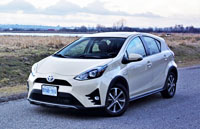
Toyota Canada stopped providing individual sales figures for its smallest hybrid back in 2017, even though the numbers weren’t much lower than in previous years. The car had been available for over five years without many updates after all, so deliveries probably should’ve slowed even more, but those of us outside of Toyota’s inner circle will never know how far they fell.
I have to admit to being curious about how the 2018 model year refresh impacted those sales results when it arrived during the same year, but unfortunately a “Prius Family” category was created for monthly Prius, Prius plug-in, Prius V and Prius C sales statistics in Canada, which meant learning how far sales had fallen through 2017, 2018 and the C’s final year of 2019, in order to question why Toyota discontinued it, became difficult.
Its cancellation may have nothing to do with sales, mind you. The Prius C shared underpinnings with the 2019 (and previous) Toyota Yaris subcompact hatchback, both having ridden on the Toyota B platform, and with the Toyota-built Vitz-based Yaris no longer available in North American markets at the close of 2019, this model now replaced by a Mazda2-based Yaris hatchback in Canada and the U.S. for 2020 (and as a Yaris sedan exclusively south of the 49th), it was probably a good idea to say sayonara to the Prius C as well.
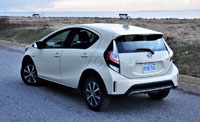
Yes, I know about the new 2020 Yaris Hybrid offered in Japan and other world markets, and I’m well aware of the even more compelling 250-plus horsepower 2020 Yaris GR (Gazoo Racing), which could’ve completely taken over from Ford’s fabulous little Fiesta ST (RIP) if Toyota had chosen to go bold, so let’s hope the new 2020 Yaris Hatchback is more enticing than the Mazda2 was when it couldn’t gain much sales traction during its mostly forgettable summer of 2010 through winter of 2016 run.
As for the outgoing 2019 Prius C, it’s a very good car now in short supply. New 2019 models are still around, plus plenty of low mileage demos and pre-owned examples. I know this because I searched across most of Canada to find the majority of new C’s in the Greater Toronto Area and in Greater Montreal (there were no new ones left in Vancouver, as they were probably scooped up by the British Columbia Automobile Association’s Evo Car Share program that primarily uses the Prius C), while the model’s highly efficient hybrid electric drivetrain will continue being produced in the aforementioned (JDM) 2020 Yaris Hybrid and upcoming (for Asia and Europe) C-HR Hybrid.
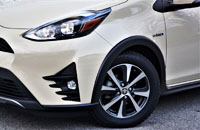
Back to the here and now, Toyota Canada is currently trying to lure in prospective 2019 Prius C buyers with zero-percent factory lease and financing rates, while all of the examples I found online were seriously discounted. These are two good reasons to consider a Prius C, but I should also point out (this being a road test review) that the little hybrid is a great little subcompact car too, all of which makes a fresh new review of this 2019 model relevant, even though we’re already so far into the 2020 calendar year (what happened to the new year?). On this note I’d like to say so long to a car that I actually enjoy spending time in, and consider its demise saddening for those of us who enjoy the fun-to-drive nature, easy manoeuvrability, and excellent efficiency of small cars.
The Yaris is a fun car to drive too, which makes sense being that both models ride on Toyota’s B platform architecture. It also makes sense for their exterior measurements not to be all that different, with the Prius C’s wheelbase stretching 40 mm (1.6 in) more than the Yaris’ to 2,550 millimetres (100.4 inches), and its overall length a significant 114 mm (4.5 in) longer from nose to tail at 4,059 mm (159.8 in). Additionally, the Prius C’s 1,715-mm (67.5-in) width makes it 20 mm (0.8 in) wider, while its 1,491-mm (58.7-in) height is actually 9 mm (0.3 in) shorter from the road surface to the topmost point of its roof.
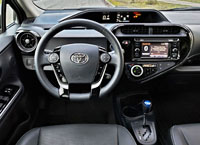
Thanks the Prius C’s renowned Hybrid Synergy Drive powertrain, which consists of a 1.5-litre Atkinson-cycle four-cylinder internal combustion engine, or ICE, incorporating variable valve timing plus an exhaust heat recovery system, a 19-kWh nickel metal-hydride battery, a 45kW (60 hp) electric motor, and auto start/stop that automatically turns the engine off when it would otherwise be idling, before restarting it upon brake pedal left-off. While the C’s ICE likely weighs similarly to the 1.5-litre four in the Yaris, all of the other gear adds a quite a bit of mass to this subcompact car. In fact, a similarly equipped 2019 Yaris SE 5-Door Hatchback with its antiquated four-speed automatic hitting the scales at just 1,050 kilos (2,335 lbs) compared to 1,147 kg (2,529 lbs) resulting in 97 kg (214 lbs), while its 99 net horsepower rating (the combination of a 73 horsepower ICE and the aforementioned electric motor) is slightly down on the regular Yaris’ 106 horses, but the electric motor’s 125 lb-ft of instant torque, combined with the ICE’s 82 lb-ft, plus the lack of mechanical drag from the Prius C’s continuously variable transmission, more than makes up for its increased mass.
Remember way back at the beginning of this review when I mentioned the Prius C is fun to drive? It’s plenty quick off the line and quite agile through fast-paced curves, feeling much the same as the sporty Yaris hatchback, but this hybrid’s ride quality might even be better. It’s actually quite refined, with a reasonably quiet cabin, even at high speeds, and good comfort over rougher pavement like inner-city laneways and bridge expansion joints.

As you might expect the Prius C is ultra-respectful at the pump too. Transport Canada rates it at 5.1 L/100km for both city and highway driving (and therefore combined too), which compares well to all rivals including Toyota’s own Yaris Hatchback that manages 7.9 L/100km city, 6.8 highway and 7.4 combined.
The car in front of you is in its second model year since a major refresh, and I particularly like the changes made to a car that was already pretty decent looking. When compared to the outrageous styling of its bigger, elder brother, the regular Prius, this refreshed C is more conservative. It features new front and rear fascias including revised LED headlights and reworked LED tail lamps, plus renewed wheel covers and available alloys, while the cabin was updated with a new steering wheel, revised primary instrument cluster, and a renewed centre stack. The new infotainment touchscreen includes a standard rearview camera, this necessary to comply with then-new regulations that mandate backup cameras for safety’s sake.

Speaking of staying safe, 2018 and 2019 Prius Cs incorporate Toyota’s Safety Sense C suite of advanced driver assistive systems as standard equipment, including automatic high beams, pre-collision warning, and lane departure alert. Additionally, the Prius C has nine airbags instead of the usual six, while direct tire pressure monitoring is now part of the base package.
As far as features go, Toyota eliminated the Prius C’s base model for 2019, which pushed the price up from $21,990 to $22,260 (plus freight and fees), but for only $270 they added everything from the previous year’s $900 Upgrade package including soft synthetic leather to the instrument panel, premium fabric upholstery, additional driver seat adjustments, cruise control, two more stereo speakers (totalling six), a rear centre console box, and a cargo cover to an ample assortment of standard equipment such as power-adjustable heated side mirrors, tilt and telescopic steering, steering wheel audio and HVAC controls, a 4.2-inch multi-information display, single-zone auto climate control, 6.1-inch touchscreen infotainment, Bluetooth, an exterior temperature gauge, etcetera.

During my search for new Prius Cs still available for sale I noticed a good mix of both trim levels, the Technology model shown on this page replacing the base car’s 15-inch steel wheels with covers for an attractive set of 15-inch alloy wheels, and the fabric upholstery swapped out for Toyota’s Softex breathable leatherette. Additionally, Technology trim enhancements include LED fog lights, proximity keyless entry with pushbutton start/stop, more sophisticated Touch Tracer controls on the much nicer synthetic leather-wrapped steering wheel, navigation, voice recognition, Gracenote connectivity, satellite radio, heated front seats, a power glass sunroof, plus more.
The 2019 Prius C Technology can be had for $27,090, which is an increase of just $140 from last year, representing great value when compared to any new hybrid. This becomes even more of deal when factoring in all the discounts I saw while searching online, not to mention the zero-percent financing Toyota is currently offering, and any other manufacturer rebates that may be available, so seriously consider snapping up a new Prius C before they’re all gone.
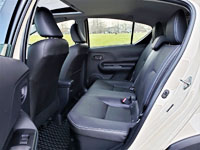
Incidentally, I sourced the financing rate and pricing right here on CarCostCanada’s 2019 Toyota Prius c Canada Prices page. CarCostCanada provides trim, package and individual option pricing on every mainstream car, SUV and truck sold in Canada, plus manufacturer rebate info, details about financing, and best of all, dealer invoice pricing that will give you an advantage when it comes time to negotiate your deal.
Interestingly, the Toyota model that probably put the final nail in the Prius C’s coffin is the entirely new 2020 Corolla Hybrid, which can be had for a reasonable $24,790 (plus destination and fees). It’s arguably a better car, but this said if you truly want or need a hatchback I can only imagine Toyota would be happy to put you into its bigger 2020 Prius, its entry price arriving at $28,550, and now optional with eAWD. The 2020 Prius Prime plug-in hybrid (PHEV) is available from $32,990 (take note that the Prime qualifies for some government rebates), while additional electrified Toyotas include the 2020 Camry Hybrid at $31,550, 2020 RAV4 Hybrid from $32,350, and the completely redesigned 2020 Highlander Hybrid from $45,490.
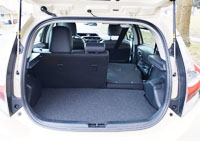
Even without the Prius C, Toyota has a lot of hybrids on offer, but take note that a new RAV4 Prime plug-in will hit the Canadian market later this year, while the awkwardly styled Mirai fuel cell electric vehicle that ended production last year is set to arrive later this year in renewed form as well, and the photos I’ve seen were much easier on the eyes.
With respect to Toyota’s plans for plug-in battery electric vehicles (BEV), such as the Nissan Leaf, in June of 2019 Toyota announced a plan to add 10 new BEV models to its worldwide fleet during the first half of this current decade, all based on a single e-TNGA platform. By 2025 the Japanese company says that each of its models will include an electrified variant, so even something like the new Supra sports car will offer a hybrid drivetrain. This is bound to become very interesting.
Until all of these innovative new models hit the market, you might want to take advantage of the great deals to be had on this 2019 Prius C, however, as it’s a very good little car that provides superb fuel economy, decent levels of refinement, a fairly spacious cabin, plus Toyota’s impressive reputation for producing durable electrified vehicles.
Story and photo credits: Trevor Hofmann
